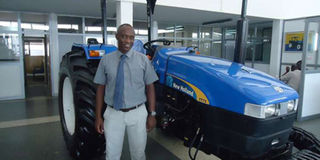Why farm machinery could be the missing link in your agribusiness

CMC Holdings' New Holland Divisional Manager, Alexander Makaa poses next to New Holland TT75 tractor. PHOTO | BRIAN OKINDA | NATION MEDIA GROUP
What you need to know:
- In crop farming, tractors, ploughs, planters, tillers and harrowers, among others, are essential as they facilitate better farming.
- Being creative and devising innovations to boost farming productivity is, therefore, encouraged as it also helps grow the country’s economy in different ways.
- In the Boresha Kilimo promotion, the banks offer farmers up to 80 per cent financing making it possible for them to purchase machinery, with low deposits and affordable seasonal payment schedule.
- Emphasis on irrigation to reduce dependence on rain-fed farming should also be of core interest of the government in the face of limited farming land and idle land deemed un-farmable due to the prevailing dry conditions.
Farm machinery is part and parcel of a successful agribusiness but many farmers shun the equipment due to high costs.
Alexander Makaa, CMC Holding’s New Holland Divisional Manager spoke to Brian Okinda on what can be done to make farm machinery accessible to all farmers, small or big.
Some farmers have learnt to work without machinery because of prohibitive costs. Are there machinery that are a must-have for any farmer, whether small or big?
For livestock farmers, depending on the size of investment, tractors, chaff-cutters, mowers, sprayers, forage harvesters and balers are some of the machinery to consider as they help in proper management and feeding of the livestock.
In crop farming, tractors, ploughs, planters, tillers and harrowers, among others, are essential as they facilitate better farming.
What is your take on farmers being creative and devising their own similar-working, albeit simple machinery, for their farming objectives?
Agriculture is the backbone of our economy, contributing about 25 per cent of our gross domestic product (GDP), while employing directly or indirectly about 75 per cent of the country’s population.
Being creative and devising innovations to boost farming productivity is, therefore, encouraged as it also helps grow the country’s economy in different ways.
What farm machinery does CMC Holdings mainly deal with?
We focus on New Holland machinery that include tractors, rotary, axial flow and forage combine harvesters.
We also have motorised sprayers, disc ploughs, planters and harrowers from Nardi, an Italian farm implements company.
We also specialise in machinery capable of being used in different environments, such as our narrow gauge tractors that can work in orchards, vineyards as well as inside greenhouses, especially for small seed crops.
Most farm machinery is considered costly especially for the smallholder farmers, what incentives do you offer in helping them acquire the equipment?
We have a range of implements that are affordable and within acquisition by the smallholder farmers. We have tractors ranging from 35 horsepower (Hp) to 670 Hp catering for farmers owning from one acre to 10,000 acres.
The smallholder farmers are, therefore, able to choose from the 35Hp to the 75Hp and they cost as low as Sh1.4 million per unit.
We have also partnered with a number of banks to boost farmers in acquisition of our products. For instance, in our promotion Boresha Kilimo, the banks offer farmers up to 80 per cent financing making it possible for them to purchase machinery, with low deposits and affordable seasonal payment schedule.
There are certain pathogens and diseases that can spread through equipment and tools, such as contagious mastitis in livestock. How would you recommend curbing this spread?
When you come to machinery, it is all about hygiene and proper management for both livestock and crop farmers. Proper cleaning of equipment keeps diseases at bay.
Are there any policies that can be formulated or changed by the government to make farm machinery accessible to farmers?
The government ought to find ways of boosting farming to increase agricultural productivity and income, especially for the smallholder farmers such as by providing subsidies on implements and helping the farmers acquire them.
Emphasis on irrigation to reduce dependence on rain-fed farming should also be of core interest of the government in the face of limited farming land and idle land deemed un-farmable due to the prevailing dry conditions.





